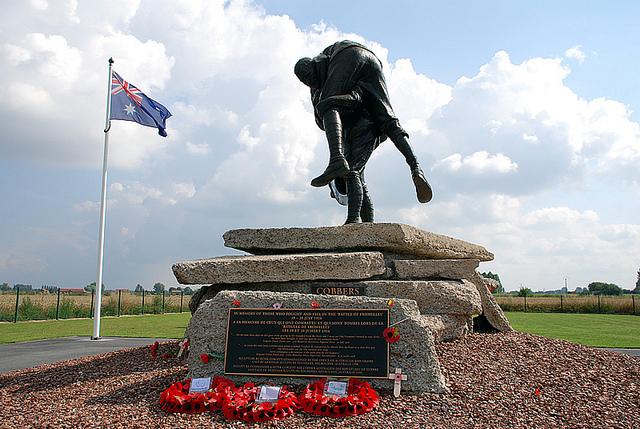
The Australian Imperial Force (AIF) proved fortunate in being spared the first day of fighting on 1 July, 1916 as the British Army attacked the Somme in northern France. That first day of the Somme offensive cost the British more than 57,000 casualties, including 19,240 dead.
Having arrived in France from Egypt in March, Australian troops of I ANZAC Corps were occupying positions in the relatively quiet ‘nursery’ sector near the town of Armentières on the Franco-Belgian border.
There they were busy learning the rigours and routine of trench warfare in their new operational theatre. They conducted fighting patrols in no man’s land, and carried out a program of aggressive trench raids against the enemy’s positions to kill and capture as many Germans as possible and collect intelligence on their operations. The British Army referred to these as ‘minor operations’, but trench raids served to weld a disparate array of combat arms into an effective fighting force before they went into battle for the first time.
In early July I ANZAC moved south, where it was drawn into the fighting on the Somme. Australian troops of the 1st Division assaulted the fortified village of Pozières on the night of 22-23 July, capturing a significant position in the Somme battlefield.
But the first major operation by the Australians on the Western Front had taken place in the ‘nursery’ sector in French Flanders only four days earlier, when troops of the newly-raised AIF 5th Division were loaned to the British IX Corps for a diversionary assault on German positions near the village of Fromelles. The battalions of the 5th Division had been in France for just two weeks. Falling under the command of General Sir Richard Haking, the 5th Division and the neighbouring British 61st Division received orders to capture a series of German positions near Fromelles. The aim was to pin down the Germans in the north and prevent their reserves from being transferred to the Somme. Zero hour was fixed for 6pm on 19 July 1916.
The assault that followed possessed all the hallmarks of the tragic first day for the British Army’s offensive on the Somme less than three weeks earlier. A concentrated bombardment did little to suppress the German defences; machine-gun positions remained active and inflicted a heavy toll as soon as the assaulting waves ‘hopped the bags’ to cross no man’s land.
Troops of the 15th Brigade were annihilated by machine-guns from a fortified salient known as the Sugar Loaf as they crossed the 300 metres of flat, featureless terrain. The German guns poured devastating fire down the length of the 5th Division’s front that ripped into the fight flank of the assaulting waves. One soldier described how ‘the bullets skimmed low, from knee to groin, riddling the tumbling bodies before they touched the ground’.
Troops of the 8th and 14th Brigades were successful in capturing the second line of enemy defences, penetrating deep into German-occupied territory. But devoid of flanking support, and struggling to repel fierce and repeated counter-attacks throughout the night, they too suffered heavily and were forced to withdraw early the following morning. Surrounded by the enemy and with little remaining ammunition with which to defend their positions, many had no other option but surrender.
In less than 24 hours, IX Corps had suffered over 7,000 casualties. A total of 5,500 of these were Australians, including 1,917 dead, 3,136 wounded and 470 taken prisoner. The British lost 1,500 casualties and the Germans 2,000. German intelligence officers searched a captured Australian and discovered orders in his pocket that revealed the purpose of the operation as nothing other than a feint.
Australian and British dead lay out in no man’s land until the end of the war, by which time none could be identified. Some 410 of them were buried in two large communal graves at VC Corner Cemetery, both marked by a large stone crucifix laid flat on the ground near where they died. Those killed in the German trenches were buried in a mass grave behind German lines that went undiscovered by war graves registration units in the years after the war.
The grave was finally located in 2009 and the bodies of 250 British and Australian soldiers killed on 19-20 July 1916 were recovered. Many were identified through a combination of anthropological, archaeological, historical and DNA techniques, and were reinterred at the new Fromelles (Pheasant Wood) Cemetery. This significant discovery proved that the ripples of that tragic action were still being felt nearly a centenary on. Descendants of missing men now buried with their names on freshly carved headstones spoke of finding ‘closure’ for trauma that had haunted their families for generations.
For Australians, Fromelles was a tragic introduction to warfare on the Western Front and hideously foreshadowed the price their nation would bear in contributing to Germany’s defeat. Hit with an additional 23,000 casualties in bitter fighting at Pozières and Mouquet Farm on the Somme, the AIF lost more men in eight weeks in France than in eight months on Gallipoli.
Tragic and costly though these losses were, they were not in vain, for the British Empire’s victory over Germany wasn’t going to occur by holding trenches for the duration of the war. For the Australians, Fromelles marked the beginning of three more years of hard fighting and rigorous training that allowed the AIF to develop into an effective fighting force that played a prominent role in Germany’s defeat in 1918.
Fromelles was one of the darkest days in Australian history, but it lay on the long and bloody road to victory on the Western Front.